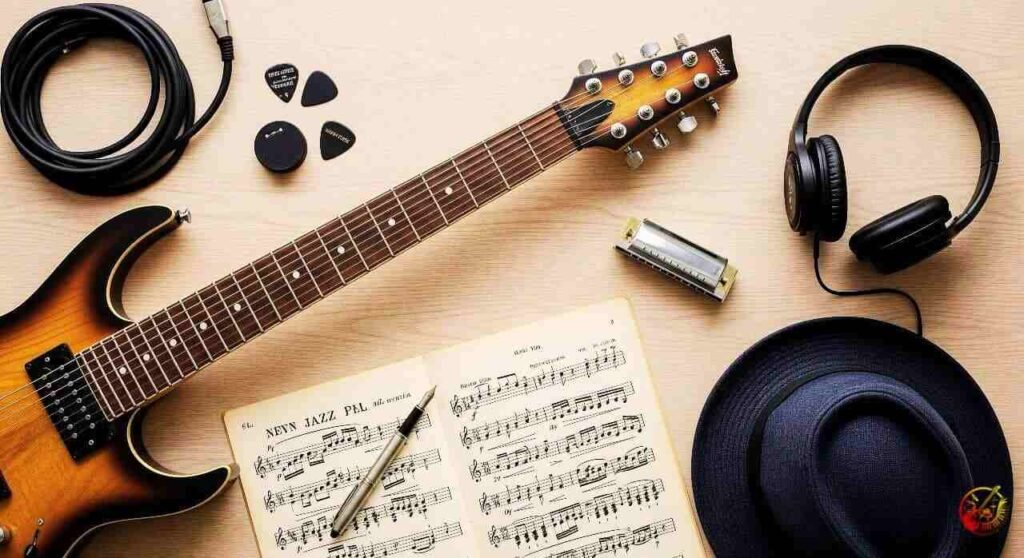Is 8 String Guitar Only for Metal? A Complete Guide
Is 8 string guitar only for metal music? No way. These extended range instruments work great in jazz, classical, progressive rock, and even pop music.
Yes, bands like Meshuggah and Animals as Leaders pushed it into the spotlight with heavy riffs and djent grooves. But treating the 8 string as a tool locked to one genre misses its real potential.
Jazz player Charlie Hunter has used them for years to play bass lines and guitar parts at the same time. The extra strings give you more notes to work with, not just heavier sounds.
This guide will show you all the different ways musicians use eight-string guitars. You’ll learn what makes them special and whether one might work for your music. We’ll look at real examples from different music styles and help you understand these versatile instruments better.
Why do people think the 8 string guitar is only for metal?

The 8 string guitar rose to fame because of metal bands. Groups like Meshuggah used it to build a massive, low-end punch that regular 6-string guitars couldn’t reach. Those extended low notes, often tuned down to F# or even lower, shaped the “djent” sound a style full of tight, palm-muted riffs and syncopated rhythms.
This metal identity stuck hard. Many guitar ads, demos, and tutorials showcase aggressive chugging or shredding when talking about 8 strings. For a new player searching online, it’s natural to assume that the instrument belongs only to the world of heavy riffs.
But here’s the twist: the instrument itself doesn’t dictate genre. A piano has 88 keys, yet nobody says it’s only for jazz or classical. The 8 string simply provides extra notes. How you use them is up to your imagination, not the genre you play.
What Music Styles Use 8 String Guitars?
Eight string guitars are used by classical, jazz, and metal guitarists, but the list goes much longer than that. Progressive rock bands love them for creating big soundscapes. Post rock musicians use the low strings to make drone sounds that fill up space without needing a bass guitar.

Jazz guitarists like Charlie Hunter blend bass notes with melody in a way that creates the illusion of two guitars. His technique lets him play walking bass lines while comping chords at the same time. This makes him sound like a whole band when he plays alone.
Classical musicians write new pieces for extended range guitars. The extra strings let them play music that was written for different instruments. Fingerstyle acoustic players also use eight-string setups to play more complex arrangements.
| Music Style | Main Use | Famous Players |
|---|---|---|
| Jazz | Bass + guitar parts together | Charlie Hunter, Stanley Jordan |
| Progressive Rock | Wide range compositions | TesseracT, Periphery |
| Classical | Extended repertoire | Various composers |
| Post-Rock | Atmospheric textures | Selected artists |
Even country and blues players sometimes pick up eight string guitars for specific songs. The extended range works well when you want to play rhythm and lead parts without switching instruments.
Why Pick an 8 String Guitar Over Regular Ones?
Musicians choose 8 string guitars to solve problems that regular guitars can’t fix. The biggest reason is range. You get super low notes and high notes on one instrument. This means you can write music that covers more ground without needing multiple guitars.
Recording becomes easier too. Home studio owners save time and money when one instrument can do the job of two. Session musicians like this because they can cover bass and guitar parts in one take.
Many players got tired of tuning their regular guitars way down low. 8 string guitars are great for progressive death metal but can also be used in other genres. The extended range gives you those low notes without making your strings all floppy and hard to play.
Expert Tip: Try different neck shapes before buying. Eight-string guitar necks are wider than regular ones. What feels good to one player might cramp another person’s hand.
The creative freedom is huge. When you’re writing music, you don’t have to think “this part needs bass guitar, this part needs regular guitar.” You can just play what sounds good and worry about the details later.
Can New Players Start With 8 String Guitars?

Starting with an eight string guitar as your first instrument has good and bad points. The main challenge is the wider neck. Your fingers need to stretch more to reach all the strings. New players might feel overwhelmed by all the choices.
But some people adapt quickly. Piano players often do well with 8 string guitars because they already think about high and low notes at the same time. Musicians with big hands might actually find the wider neck comfortable.
The learning curve gets steeper because you have more strings to manage. Each string can make noise if you don’t control it properly. This means you need to learn muting techniques early on.
| Learning Factor | Good Points | Challenges |
|---|---|---|
| Physical | More musical options | Wider neck to handle |
| Theory | Encourages full thinking | More complexity |
| Resources | Online lessons available | Fewer beginner books |
| Cost | Better quality available | Usually costs more |
Most teachers suggest starting with six strings first. But if you really want an 8 string guitar and you’re willing to work harder, there’s no rule against it. Just expect to spend more time on basic techniques.
How Does Playing Technique Change?
Playing an 8 string guitar uses most of the same skills as regular guitar. The biggest difference is managing all those extra strings. You need to mute the ones you’re not using, especially the low ones. They can buzz and make unwanted noise if you’re not careful.
Chord shapes work differently too. Regular chord patterns might sound muddy on the low strings. Many players learn to split their chords, putting bass notes on the low strings and treble notes up high. This creates a fuller sound than traditional chords.
Your picking hand needs to adjust. Palm muting becomes more important for controlling string noise. Adapting your picking technique is crucial when you have eight strings to deal with instead of six.
The neck size affects your fretting hand too. You might need to change how you position your thumb and fingers. Some players find their hand gets tired faster until they build up strength.
Many 8 string players develop hybrid techniques. They blur the line between rhythm and lead guitar because they can play bass parts and melody at the same time. This creates new possibilities but requires different practice methods.
How Do 8 String Guitars Work in Bands?
Band arrangements change when you add an eight string guitar. The extra range can make the bass guitar less necessary in some songs. This works great for three piece bands where one guitar player can cover more musical territory.
Picking bass notes with his right thumb while fretting them with his left index finger (while at the same time fingerpicking guitar chords and single notes), Hunter achieves the real sound of multiple instruments. This technique shows how one player can fill the role of several band members.
Jazz groups benefit differently. The extended range guitar can provide walking bass lines and chord accompaniment simultaneously. This makes duo performances sound much fuller than they would with regular guitar.
In recording situations, engineers need to think about frequency management. The low end of an eight-string guitar can clash with bass guitar and drums if not mixed carefully. Some producers separate the low and high strings into different tracks for better control.
| Band Type | Guitar Role | Benefits |
|---|---|---|
| Power Trio | Bass + rhythm + lead | More complete sound |
| Jazz Combo | Walking bass + chords | Fuller harmonic base |
| Studio Work | Multi-instrument | Fewer overdubs needed |
| Solo Performance | Complete arrangement | One-person band sound |
The key is understanding what frequencies each instrument covers. Smart arrangements use the 8 string guitar’s range without stepping on other instruments’ territory.
Are There Special Tuning Methods for Different Styles?
Different music styles use different tuning approaches for 8 string guitars. Metal commonly uses standard tuning (F# B E A D G B E), which just adds two lower strings to regular guitar tuning. This makes the transition easier for players coming from 6 string guitars.
Jazz players often prefer tunings that help with chord melody playing. Charlie Hunter tunes the bottom three strings like a bass (EAD) and the top five strings like a guitar (ADGBE). This setup lets him play bass lines and guitar parts clearly.
Classical and fingerstyle players choose tunings based on specific pieces. They might use open tunings that create natural harmonies across all eight strings. Some tune in all fourths for consistent interval relationships.
String gauge selection matters a lot with different tunings. Lower tunings need heavier strings to stay tight and play in tune. But super heavy strings make bending notes harder on the high end. Finding the right balance takes experimentation.
Pro Tip: Keep notes about different tunings you try. Write down not just the notes, but also what string weights you used and any setup changes. This saves time when you want to switch back later.
The extended range opens up tuning possibilities that regular guitars can’t achieve. Some players create tunings specifically for certain songs or compositional ideas.
What Equipment Do You Need?
8 string guitars need different gear than regular guitars. The extended frequency range can overwhelm equipment not designed for it. Standard guitar pickups might sound muddy on the low strings, while standard amps might not handle the bass frequencies well.
8 string electric guitars are available from brands including Schecter, Ibanez and Strandberg. These companies make pickups specifically designed for extended range instruments. The pickups have tighter magnetic fields and better frequency response for all eight strings.
Amplification becomes tricky. Guitar amps might not reproduce the low frequencies properly, while bass amps might make the high strings sound dull. Many players use full range PA systems or separate amps for the low and high strings.
String selection involves more variables than regular guitars. The tension needs to feel balanced across all eight strings. Standard string set ratios don’t always work well with eight string configurations. Many players end up buying individual strings to create custom sets.
| Equipment Type | 8-String Needs | Important Points |
|---|---|---|
| Pickups | Wide frequency response | Active vs passive options |
| Amplification | Full-range capability | Multiple amp solutions |
| Strings | Balanced tension | Custom gauges often needed |
| Cases | Extended length | Standard cases don’t fit |
Setup and maintenance get more complex with eight strings. More string tension puts more stress on the neck, requiring more frequent adjustments. Intonation becomes trickier because of the varying string weights and tensions.
Final Thoughts
Is 8 string guitar only for metal? Absolutely not. These versatile instruments work in jazz, classical, progressive rock, and many other styles. While they need some technique adjustments and different equipment, eight string guitars offer creative possibilities that regular guitars can’t match. The extended range lets musicians cover more musical ground with one instrument.
Whether an 8 string guitar fits your music depends on your goals and willingness to adapt. Consider trying one before buying to see if the wider neck and extra strings work for you. The learning curve might be steeper, but the musical rewards go far beyond heavy metal.
As more musicians discover applications outside metal genres, 8 string guitars will likely become even more common. The question “is 8 string guitar only for metal” will become completely outdated as these instruments find their place in every style of music.
FAQ: Is 8 String Guitar Only for Metal?
1. What is an 8 string guitar tuned to?
An 8-string guitar is tuned F-sharp B E A D G B E from lowest to highest string. This is called standard 8-string tuning. The two extra strings (F# and B) add lower notes below a regular guitar’s range. Some players use different tunings like drop E or all-fourths tuning depending on their music style.
2. Are 8 string guitars harder to play than regular guitars?
Yes, 8 string guitars are more challenging than regular guitars. More strings equal more complexity, after all. The wider neck requires bigger finger stretches, and you need to learn proper muting techniques to control string noise. However, most of your existing guitar skills transfer over – it’s mainly about adapting to the extra strings and wider fretboard.
3. Can beginners start with an 8 string guitar?
Starting with an 8 string guitar as your first instrument is possible but not recommended. The 7-string feels more versatile than the 8-string which seems like a good idea for a beginner. The wider neck and extra complexity can overwhelm new players. Most guitar teachers suggest learning on a 6-string first, then moving to extended range instruments once you have solid fundamentals.
4. What music genres use 8 string guitars?
8 string guitars aren’t just for metal music. Jazz players like Charlie Hunter use them to play bass lines and guitar parts simultaneously. Progressive rock, classical, post-rock, and even some country musicians use extended range guitars. The extra strings provide more tonal possibilities rather than just “heavier” sounds.
5. Do you need special equipment for 8 string guitars?
Yes, 8 string guitars require some specialized gear. You need pickups designed for extended frequency range, and regular guitar amps might not handle the low frequencies well. You’ll want to get some heavier gauge strings for the low strings to maintain proper tension. Standard guitar cases usually don’t fit 8-string guitars either.
6. What string gauges work best for 8 string guitars?
String gauge depends on your tuning, but the lowest strings typically need .070 gauge or heavier. Your low E (or F#) needs at least .074, never smaller than a .070. Many players use custom string sets rather than standard packages because the tension needs to feel balanced across all eight strings. Lighter gauges on low strings create buzz and tuning problems.
7. How do chord shapes work on 8 string guitars?
Regular chord shapes can sound muddy on 8 string guitars, especially using the low strings. Many players learn to split chords across the range – putting bass notes on the low strings and treble notes higher up. Guitarists can experiment with complex chord voicings, full harmonies, and challenging melodies. You’ll need to adapt familiar chord patterns rather than just playing them the same way.
8. Are 8 string guitars worth the investment?
8 string guitars are worth it if you want extended range and creative possibilities that regular guitars can’t provide. They work great for recording since one instrument can cover bass and guitar parts. However, they cost more than regular guitars, require specialized equipment, and have a steeper learning curve. Consider your musical goals and whether the extra range fits your style before investing.
